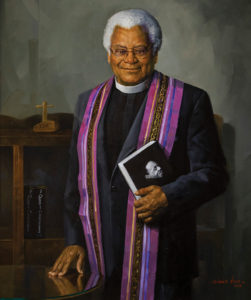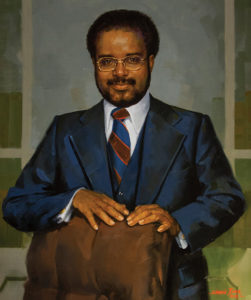
Chancellor Nicholas S. Zeppos unveiled four portraits during Reunion weekend in October that are part of a new Vanderbilt Trailblazers portrait series honoring members of the Vanderbilt community who broke barriers at the university and in society at large. The portraits depict Vanderbilt alumni Bishop Joseph Johnson, BDiv’54, PhD’58; the Rev. James Lawson, ’71; the Rev. Walter R. Murray Jr., BA’70, MMgmt’74; and Perry Wallace, BE’70.

“I truly believe that symbols, pictures, history, culture and the revelation of hidden figures have to be part of the project of the university,” Zeppos says. “We do things at Vanderbilt that last for hundreds of years, so let’s get off to a good start. We’ve got a lot more walls to fill and a lot more pioneers.”
The Trailblazers portraits are the first portraits of African Americans to be displayed in Kirkland Hall, where they will remain until dedicated in their permanent locations across campus later this year.
Zeppos commissioned world-renowned artist Simmie Knox for the project. Knox has painted portraits of numerous high-profile public figures, including Oprah Winfrey, Muhammad Ali, and Supreme Court Justices Thurgood Marshall and Ruth Bader Ginsburg, as well as the official White House portraits of President Bill Clinton and First Lady Hillary Clinton.
The Vanderbilt Trailblazers portraits are part of a wider effort to establish symbols, art, buildings,  places and programs that represent and reflect the diversity within the Vanderbilt community.
places and programs that represent and reflect the diversity within the Vanderbilt community.
A similar project includes the recently unveiled Legacy Pioneers portraits at the Bishop Joseph Johnson Black Cultural Center.
The pioneer portraits—of Rev. Walter R. Murray Jr.; Chancellor Nicholas S. Zeppos; Eileen Carpenter, BA’69; Sheryll Cashin, BE’84; Peter Pratt; Ray Winbush; Tonya Mitchell; Dr. Monica Peek, BS’91; Akaninyene Ruffin, BA’17; and former Chancellor Gordon Gee—were painted by James Threalkill, BS’79, and are displayed in the Black Cultural Center’s study lounge.
“I hope that by learning about the legacy pioneers and engaging with the university’s racial history, students will have a greater appreciation for their current experience,” says Rosevelt Noble, BS’97, PhD’03, assistant dean of students and director of the Black Cultural Center. “Vanderbilt has not always been like it is now. It’s important for students who frequent the Black Cultural Center to realize that a lot of people made significant sacrifices to make their experience what it is today.”